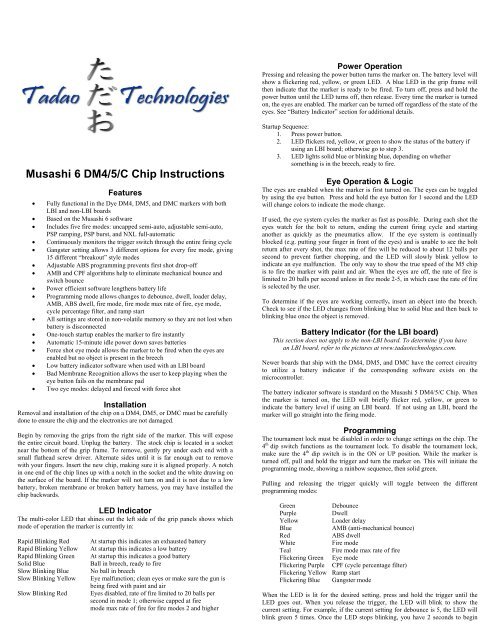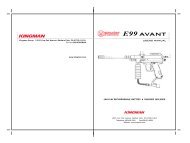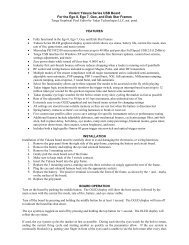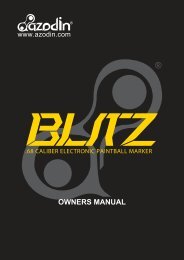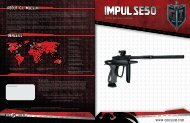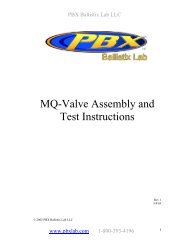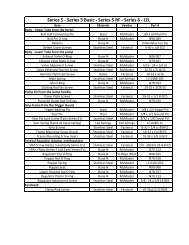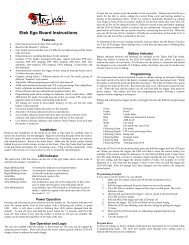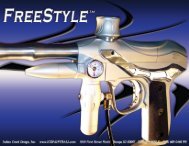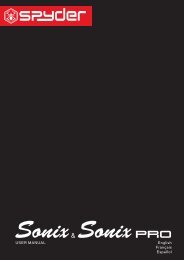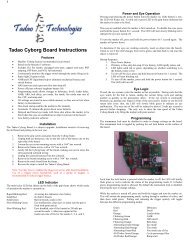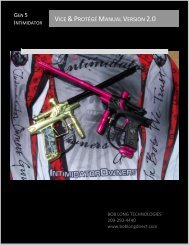Musashi 6 DM4/5/C Chip Instructions - Tadao Technologies
Musashi 6 DM4/5/C Chip Instructions - Tadao Technologies
Musashi 6 DM4/5/C Chip Instructions - Tadao Technologies
- No tags were found...
Create successful ePaper yourself
Turn your PDF publications into a flip-book with our unique Google optimized e-Paper software.
Power OperationPressing and releasing the power button turns the marker on. The battery level willshow a flickering red, yellow, or green LED. A blue LED in the grip frame willthen indicate that the marker is ready to be fired. To turn off, press and hold thepower button until the LED turns off, then release. Every time the marker is turnedon, the eyes are enabled. The marker can be turned off regardless of the state of theeyes. See “Battery Indicator” section for additional details.<strong>Musashi</strong> 6 <strong>DM4</strong>/5/C <strong>Chip</strong> <strong>Instructions</strong>Features• Fully functional in the Dye <strong>DM4</strong>, DM5, and DMC markers with bothLBI and non-LBI boards• Based on the <strong>Musashi</strong> 6 software• Includes five fire modes: uncapped semi-auto, adjustable semi-auto,PSP ramping, PSP burst, and NXL full-automatic• Continuously monitors the trigger switch through the entire firing cycle• Gangster setting allows 3 different options for every fire mode, giving15 different “breakout” style modes• Adjustable ABS programming prevents first shot drop-off• AMB and CPF algorithms help to eliminate mechanical bounce andswitch bounce• Power efficient software lengthens battery life• Programming mode allows changes to debounce, dwell, loader delay,AMB, ABS dwell, fire mode, fire mode max rate of fire, eye mode,cycle percentage filter, and ramp start• All settings are stored in non-volatile memory so they are not lost whenbattery is disconnected• One-touch startup enables the marker to fire instantly• Automatic 15-minute idle power down saves batteries• Force shot eye mode allows the marker to be fired when the eyes areenabled but no object is present in the breech• Low battery indicator software when used with an LBI board• Bad Membrane Recognition allows the user to keep playing when theeye button fails on the membrane pad• Two eye modes: delayed and forced with force shotInstallationRemoval and installation of the chip on a <strong>DM4</strong>, DM5, or DMC must be carefullydone to ensure the chip and the electronics are not damaged.Begin by removing the grips from the right side of the marker. This will exposethe entire circuit board. Unplug the battery. The stock chip is located in a socketnear the bottom of the grip frame. To remove, gently pry under each end with asmall flathead screw driver. Alternate sides until it is far enough out to removewith your fingers. Insert the new chip, making sure it is aligned properly. A notchin one end of the chip lines up with a notch in the socket and the white drawing onthe surface of the board. If the marker will not turn on and it is not due to a lowbattery, broken membrane or broken battery harness, you may have installed thechip backwards.LED IndicatorThe multi-color LED that shines out the left side of the grip panels shows whichmode of operation the marker is currently in:Rapid Blinking RedRapid Blinking YellowRapid Blinking GreenSolid BlueSlow Blinking BlueSlow Blinking YellowSlow Blinking RedAt startup this indicates an exhausted batteryAt startup this indicates a low batteryAt startup this indicates a good batteryBall in breech, ready to fireNo ball in breechEye malfunction; clean eyes or make sure the gun isbeing fired with paint and airEyes disabled, rate of fire limited to 20 balls persecond in mode 1; otherwise capped at firemode max rate of fire for fire modes 2 and higherStartup Sequence:1. Press power button.2. LED flickers red, yellow, or green to show the status of the battery ifusing an LBI board; otherwise go to step 3.3. LED lights solid blue or blinking blue, depending on whethersomething is in the breech, ready to fire.Eye Operation & LogicThe eyes are enabled when the marker is first turned on. The eyes can be toggledby using the eye button. Press and hold the eye button for 1 second and the LEDwill change colors to indicate the mode change.If used, the eye system cycles the marker as fast as possible. During each shot theeyes watch for the bolt to return, ending the current firing cycle and startinganother as quickly as the pneumatics allow. If the eye system is continuallyblocked (e.g. putting your finger in front of the eyes) and is unable to see the boltreturn after every shot, the max rate of fire will be reduced to about 12 balls persecond to prevent further chopping, and the LED will slowly blink yellow toindicate an eye malfunction. The only way to show the true speed of the M5 chipis to fire the marker with paint and air. When the eyes are off, the rate of fire islimited to 20 balls per second unless in fire mode 2-5, in which case the rate of fireis selected by the user.To determine if the eyes are working correctly, insert an object into the breech.Check to see if the LED changes from blinking blue to solid blue and then back toblinking blue once the object is removed.Battery Indicator (for the LBI board)This section does not apply to the non-LBI board. To determine if you havean LBI board, refer to the pictures at www.tadaotechnologies.com.Newer boards that ship with the <strong>DM4</strong>, DM5, and DMC have the correct circuitryto utilize a battery indicator if the corresponding software exists on themicrocontroller.The battery indicator software is standard on the <strong>Musashi</strong> 5 <strong>DM4</strong>/5/C <strong>Chip</strong>. Whenthe marker is turned on, the LED will briefly flicker red, yellow, or green toindicate the battery level if using an LBI board. If not using an LBI, board themarker will go straight into the firing mode.ProgrammingThe tournament lock must be disabled in order to change settings on the chip. The4 th dip switch functions as the tournament lock. To disable the tournament lock,make sure the 4 th dip switch is in the ON or UP position. While the marker isturned off, pull and hold the trigger and turn the marker on. This will initiate theprogramming mode, showing a rainbow sequence, then solid green.Pulling and releasing the trigger quickly will toggle between the differentprogramming modes:GreenDebouncePurpleDwellYellowLoader delayBlueAMB (anti-mechanical bounce)RedABS dwellWhiteFire modeTealFire mode max rate of fireFlickering Green Eye modeFlickering Purple CPF (cycle percentage filter)Flickering Yellow Ramp startFlickering Blue Gangster modeWhen the LED is lit for the desired setting, press and hold the trigger until theLED goes out. When you release the trigger, the LED will blink to show thecurrent setting. For example, if the current setting for debounce is 5, the LED willblink green 5 times. Once the LED stops blinking, you have 2 seconds to begin
entering the new setting.To enter the new setting, pull the trigger the desired number of times. For example,to set the debounce to 2, you must pull the trigger 2 times. Every time you pull thetrigger the LED will light. After all settings have been changed, turn the markeroff, using the power button.Programming ExampleIf you want to set the dwell to 20, you should:1. Make sure the marker is powered off and the tournament lock isdisabled (4 th dip switch in the UP/ON position).2. Pull the trigger and push the power button to turn on the marker.3. The LED shows a rainbow sequence, then solid green. This is thedebounce mode.4. Quickly pull and release the trigger 1 time to switch to the dwell mode.The LED will show purple.5. Pull and HOLD the trigger until the LED turns off.6. Release the trigger. The LED will blink out the current setting.7. When the LED stops blinking, enter the new setting by pulling thetrigger 20 times.8. Wait until the LED turns back on, indicating programming has beencompleted.9. Turn the marker off.Program ResetTo reset all settings to factory defaults, hold down the eye button for 10 secondswhile in programming mode. The LED will rapidly cycle through every settingcolor to indicate that the process has completed.SettingsDebounce – The <strong>Musashi</strong> software features a hybrid debounce scheme that usesmicrocontroller cycles to debounce the pull of the trigger and ½ ms timeincrements to debounce the release. This results in a very effective debouncealgorithm that does not hinder the user at any setting. At low debounce settings,however, it may cause the marker to read switch bounce as additional pulls, falselygenerating shots or near full automatic fire. The setting ranges from 1 to 50 and isdefaulted at 10.Dwell – The amount of time the solenoid is energized each time the marker isfired. The default is 18 ms. The range is 5 to 30 ms. Too low of a dwell may leadto inconsistency or drop-off. Too high of a dwell can cause bad air efficiency.Loader delay – Adds a slight delay after the eye has seen a ball and the bolt iscycled, causing the gun to fire. If not using force fed loaders, it may be necessaryto increase this setting to prevent chopping. A setting of 1 means no loader delay,which is the fastest. The default is 2 and may be set from 1 to 50.AMB – Allows the user to adjust the anti-mechanical bounce feature. Mechanicalbounce occurs with the <strong>DM4</strong>, DM5, and DMC due to the kick generated duringeach shot and can cause the marker to “run away,” firing even after the trigger hasbeen released. AMB helps stop markers from going full-auto when the trigger ispulled very slowly. The default is 2 and may be set from 1 to 5 (1 being off). AMBis only used in fire modes 1 and 2 (semi-automatic unlimited and capped).ABS dwell – Amount of dwell time added for an ABS shot. The range is from 1 to15 additional milliseconds of dwell. The default is 5. ABS can be disabled bysetting the 1 st dip switch to the down/off position. For a more detailed explanationof ABS see the “Additional Features” section.Fire mode – Included are five different fire modes (default is 1):1. Semi-automatic, unlimited rate of fire2. Semi-automatic, adjustable rate of fire3. PSP ramping, adjustable rate of fire4. PSP burst, adjustable rate of fire5. NXL full-automatic, adjustable rate of fireSetting 1 is normal semi-automatic with an unlimited rate of fire while the eyes areenabled. When the eyes are turned off, the max rate of fire is set to 20 balls persecond.Setting 3 is the first PSP fire mode that works as follows:• The first 3 shots of a string are semi-automatic.• After the 4 th shot the marker will add shots as long as the user firesfaster than the ramp start setting. For example, if the ramp start settingis 5, the user must pull 5 times per second or faster for the software toadd additional shots.• If the trigger is released, the marker will stop firing immediately.• If the trigger is not pulled again within 1 second of release, the 3-shotsemi-automatic count starts over.Setting 4 is the second PSP fire mode that works as follows:• The first 3 shots of a string are semi-automatic.• After the 4 th shot the marker will fire 2 or more shots per pull as long asthe user continually pulls and releases the trigger.• If the trigger is released, the marker will stop firing immediately.• If the trigger is not pulled again within 1 second of release, the 3-shotsemi-automatic count starts over.In normal operation, continually pulling the trigger faster than 5 to 6 pulls persecond will effectively give the user full-automatic at the max rate of fire. If theuser stops shooting then resumes within 1 second, the marker will return to themax rate of fire. If the user stops shooting for more than 1 second, the next 3 shotswill be semi-automatic. On the 4 th shot it will resume a faster fire rate.PSP ramping and PSP burst differ in that PSP ramping requires the user tomaintain the ramp start rate of fire for software assistance, whereas the PSP burstmode will fire at least 2 shots per pull, regardless of rate of fire. Some playersprefer multiple shots every time they pull the trigger after the initial 3 semiautomaticshots, while others like to shoot 1 ball at a time until they achieve acertain rate of fire.Setting 5 is the NXL full-automatic fire mode. It functions similarly to the PSPfire modes except, after the 3 rd semi-automatic shot, the user may pull and hold thetrigger for the marker to fire in full-automatic.Fire mode max rate of fire – The max rate of fire setting applies to the 2nd –12th fire modes. The max rate of fire is adjustable from 10 to 25 balls per second,and has an unlimited setting for maxing out the loader system. The default is 7,which is roughly 13 balls per second. Oscillator inconsistencies from chip to chipmake it impossible to time perfectly, so the only true way to check rate of fire is touse a Pact Timer or ballistic chronograph. The red radar chronographs commonlyfound at fields are NOT reliable.Setting BPS Setting BPS1 10.0 12 15.52 10.5 13 16.03 11.0 14 17.04 11.5 15 18.05 12.0 16 19.06 12.5 17 20.07 (default) 13.0 18 21.08 13.5 19 22.09 14.0 20 23.010 14.5 21 24.011 15.0 22 Unlimited eyes on, 25.0 bps eyes offEye mode – Two eye modes are available:1. Delayed – The marker fires ½ second after every trigger pull regardlessof a ball in the breech. This is useful for sound activated loadersbecause it insures that a shot is fired, even without paint, so the loaderwill continue to feed.2. Forced with force shot – The marker only fires if paint is seen in thebreech or the user pulls and holds the trigger for ½ second, thusinitiating a force shot.Setting 2 is semi-automatic with a capped rate of fire. It limits the maximum ballsper second that can be fired. The cap is set by the Max ROF setting.
Cycle percentage filter (CPF) – The cycle percentage filter allows adjustment ofthe point within the current firing cycle that a new buffered shot is allowed.Almost all electronic paintball markers allow a single shot to be buffered in theevent the user is fast enough to release the trigger and pull again during the currentfiring cycle. The CPF setting is adjustable from 1 to 10. Setting 1 turns the CPFoff, allowing buffered shots at any point in the firing cycle. Setting 2 through 10sets the percentage of the firing cycle that must pass before shots may be buffered:1. CPF turned off2. 10% of the firing cycle must pass before a buffered shot is allowed3. 20%4. 30%5. 40%6. 50%7. 60%8. 70%9. 80%10. 90%A higher CPF setting results in less unintentional bounce. For instance, it ispossible that if your debounce setting is border line, you can fire the marker a fewtimes then hold it loosely and allow it to brush against your finger, going fullautomatic.Since most switch bounce from either a low debounce setting ormechanical bounce occurs almost immediately after the trigger is released, CPFcan be very effective in eliminating falsely generated trigger activity.Ramp start – The ramp start setting is only used for the PSP ramping fire mode(mode 3). It sets the minimum pulls per second that must be maintained for thesoftware to add shots or ramp up to the maximum rate of fire setting. The defaultis 5 and is adjustable from 4 to 12 pulls per second.Gangster mode – <strong>Musashi</strong> 6 includes a special mode that can be applied threedifferent ways to each of the 5 fire modes, giving 15 “breakout” stylecombinations. Gangster mode gives the user full-automatic with an unlimited rateof fire for a single pull, for use at the start of the game. The setting is defaulted at4, which turns gangster mode off. A setting of 1-3 dictates at which pull thatgangster mode will become active. If set to 1, the first shot after you turn on themarker will be full-automatic with an unlimited rate of fire for as long as you holddown the trigger. As soon as you release the trigger, the marker will stop shootingand default back to your selected fire mode. If set to 3, the gangster mode will beactive on the third shot after the marker is turned on. Regardless of the fire modeselected, the shots before the gangster mode will be semi-automatic. Gangstermode can only be used once for each time the marker is turned on.Note: The gangster mode is illegal for use in all tournament series. <strong>Tadao</strong><strong>Technologies</strong> LLC takes no responsibility for the user’s choice in using thegangster mode.Dip Switches:Dip 1 ABS toggle, UP/ON for ABS enabledDip 2 Not used, leave UP/ONDip 3 Not used, leave UP/ONDip 4 Tournament lock, UP/ON for lock disabledAdditional FeaturesBad Membrane Recognition – If the eye button on the membrane pad fails, thesoftware recognizes it at boot-up and disables it completely. This allows the userto continue playing with the eye system enabled. It is not necessary to check thepower button on the membrane pad. If it goes bad, the marker cannot be turned on.Force Shot feature – If using the forced eye mode and the eyes are enabled, thebreech is empty, and the user wants to fire a clearing shot, a force shot can beinitiated by pulling and holding the trigger for ½ second. This is useful with forcefed loaders that sometimes push a ball slightly into the detents where the eyes areunable to see it. After force firing, the next ball will load and operation cancontinue as normal.A tip for setting the debounce, AMB, and CPF – This only applies to semiautomaticfire modes (modes 1 and 2) since AMB is disabled in the PSP firemodes or NXL mode.Debounce, AMB, CPF setup steps, while using air (no paint):1. Turn AMB and CPF off (set both to 1).2. Starting at debounce 1-3, raise the debounce setting a notch at a timeuntil excessive trigger bounce goes away. The goal is to have one pull,one shot, regardless of rate of fire. Do NOT slow pull test for bounceduring this phase. Instead, pull the trigger rapidly or walk it, listeningfor double or triple fires.3. When it appears that it is only one shot, one pull for solid trigger pulls,try the slow pull test. Holding the marker steady, slowly pull thetrigger and see if multiple shots can be generated from the single pull.4. Increase the CPF setting a notch at a time until the slow pull bouncestarts to disappear. An additional test is to fire a few rounds quickly,then hold the trigger right on the activation point to see if the markerwill run away.5. If you reach setting 10 with CPF and the marker can still be slow pulledto fire full-automatic, then your debounce setting is probably too low.Go back to step 2.6. AMB should not be set above 3, if possible, since it is not astransparent to the user as CPF. Even a CPF setting of 10 will not benoticed by the user.Example Setting Profiles:1. Tournament legal semi-automatic (NPPL)a. Fire mode 1 or 2 (semi-automatic unlimited or capped)b. Debounce 5-20c. AMB 2d. CPF 2-5e. Loader delay set to match your loader (1-4 for Halo, 4-10for gravity feed)2. PSP X-Ball, CFOA, Millenniuma. Fire mode 3 or 4 (Millennium requires mode 3)b. Max rate of fire set to 3-5, depending on Pact Timerreadings. To be safe use setting 3 (14.5 balls per second).c. Debounce 5-20d. Ramp start 5 or higher if using PSP rampinge. Ramp start 8 or higher if playing Millenniumf. Loader delay set to match your loader (1-4 for Halo, 4-10for gravity feed)3. NXLa. Fire mode 5 (NXL full-automatic)b. Max rate of fire set to 3-5, depending on Pact Timerreadings. To be safe, use setting 3 (14.5 balls per second).c. Debounce 5-20d. Loader delay set to match your loader (1-4 for Halo, 4-10for gravity feed)4. Ludicrous Speed (absolute fastest/bounciest)a. Any fire modeb. Max rate of fire set to 26 (unlimited)c. Debounce 1d. AMB 1 if using semi-automatice. CPF 1f. Ramp start 4 if using PSP rampingg. Loader delay 1Additional Informationwww.tadaotechnologies.comABS – ABS (anti-bolt stick) programming helps to eliminate first shot drop-off.First shot drop-off occurs when the lube and o-rings settle or “stick” inside themarker after it has been sitting. The next shot fired will be lower in velocitybecause the bolt has to break free. ABS will slightly increase the dwell tocompensate if the marker is left sitting for 15 seconds.


